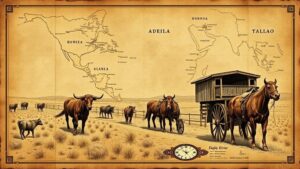Applying AI to Decode Symbols and Inscriptions on Ancient Treasure Maps
Applying AI to Decode Symbols and Inscriptions on Ancient Treasure Maps
The advent of artificial intelligence (AI) has opened new avenues for the study of historical artifacts, including ancient treasure maps. These maps, often replete with symbols and inscriptions, have captivated historians, archaeologists, and treasure hunters alike. The application of AI, particularly in machine learning and image recognition, has the potential to decode these intricate symbols and yield valuable insights into human history.
Historical Context of Treasure Maps
Treasure maps have been a part of human history for centuries, often depicting rumored locations of buried treasures or lost artifacts. Notable examples include the “Madoc” map from the 12th century, which is said to show the location of treasures in North America. Similarly, the “Mappa Mundi,” created around 1300 in England, illustrates not just geography but also the beliefs and myths of the time.
These maps typically feature a combination of geographic markers, symbols, and inscriptions in various languages and scripts, often making them challenging to interpret. Traditional methods of analysis by historians and archaeologists often struggle to decode these symbols, leading to a demand for innovative approaches.
The Role of Artificial Intelligence
AI techniques, particularly those involving machine learning, are increasingly being employed in the analysis of ancient texts and glyphs. For example, convolutional neural networks (CNNs) can be trained to recognize patterns within visual data. This capability is valuable when applied to ancient symbols, which may be obscured or damaged over time.
Machine Learning Approaches
Machine learning algorithms can be trained on datasets containing examples of various symbols and inscriptions from known treasure maps. By exposing the model to a wide variety of these symbols, the algorithm learns to recognize and categorize new symbols it encounters. This is similar to how a child learns to identify animals–by repeatedly observing and being informed about attributes of different species.
For example, researchers at Stanford University successfully employed AI algorithms to analyze scans of ancient inscriptions from the Mediterranean region, achieving an accuracy rate of over 85% in identifying and categorizing different symbols. Such accomplishments exemplify the potential for AI to extend our understanding of ancient documents.
Case Study: The Vinland Map
The Vinland Map, believed to date back to the 15th century and thought to depict areas of North America, presents an excellent case for applying AI technologies. Scholars have debated its authenticity for decades, focusing primarily on the symbols that annotate the map.
Recent studies utilizing AI methods have aimed to analyze the pigments and inscriptions found on the map. By implementing multispectral imaging and machine learning algorithms, researchers at Yale University were able to uncover unseen details within the map’s inscriptions, revealing additional text that had previously gone unnoticed.
Real-World Applications
The application of AI in deciphering ancient treasure maps holds not just academic value but practical implications as well. Improved decoding methods can lead to the recovery of lost historical treasures and artifacts, as well as enhance tourism prospects in regions with rich historical backgrounds.
- Increased accuracy in identification of historical locations can fuel archaeological excavations.
- Enhanced educational resources enabling museums to present richer narratives around ancient civilizations.
- Potential partnerships with tech companies in heritage preservation projects.
Challenges and Ethical Considerations
Despite the positive implications of applying AI to ancient inscriptions, challenges persist. Issues related to data quality, algorithmic bias, and the context of symbols must be addressed. AI models trained on biased datasets can produce misleading results, leading to misinterpretations of historical contexts.
Also, ethical considerations surrounding the preservation of cultural heritage emerge as technology advances. The collaboration between technologists and historians must ensure that the AI methodologies employed respect the integrity of ancient symbols and their cultural significance.
Conclusion and Future Directions
AI represents a transformative force in the field of historical research, especially concerning the decoding of symbols and inscriptions on ancient treasure maps. As methodologies continue to evolve, the potential for breakthroughs in understanding human history grows exponentially. Future research should focus on cross-disciplinary collaborations that incorporate AI, historical linguistics, and archaeology, fostering a holistic approach to uncovering the mysteries of the past.
Actionable steps for researchers include:
- Establishing partnerships with AI experts to develop specialized algorithms for symbol recognition.
- Investing in the digitization of ancient maps to create comprehensive datasets for training AI models.
- Fostering open-access platforms for sharing findings to build a collaborative academic community.
The fusion of artificial intelligence with the study of ancient treasure maps not only enhances our understanding of history but also paves the way for significant archaeological discoveries in the future.



